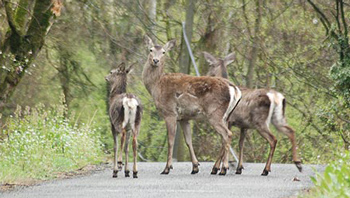SRINAGAR: Satellite collars are being fitted on a group of Hangul, a rare Red Deer species found only in this Himalayan region, in a bid to better understand their behaviour.
A team of scientists hid inside caves in the upper reaches of the Dachigam National park for two days for their first catch. That Hangul was collared on Saturday.
“We hope to fit the tiny equipment on few others during this week”, says Dr Khursheed Ahmad, Principal Investigator and head of wildlife department at Sher-e-Kashmir University of Agricultural Sciences, which has been conducting the project in collaboration with the Wildlife Institute of India, Dehradun.
“After fitting the collars on the animals, we will monitor their movement outside the Dachigam Park for three years. The data collected from these devices will give us an exact picture of the habitation and range of the Kashmir hangul”, he said.
The Hangul, a majestic looking deer with a brownish coat and two antlers, was believed to have ranged over a humongous area – from the forests to Kishtawar in Jammu province to Kishangana in north Kashmir. But now it is found mostly in the forests of Dachigam, a short drive from Srinagar, Kashmir’s summer capital.
Poached for its meat, antlers and skin, their numbers have been on the decline since 1940s due to altered male-female ratio and a bevy of habitat complications.
From around 3,000, the figure dropped to 900 in 1989. As militants and the army battled in forests after an armed conflict began in the early nineties, the hangul population dwindled further to a mere 200.
Official apathy and lack of effective scientific intervention for the species’ survival shattered hope that the Hangul will not be extinct.
The authorities earlier started a program for captive breeding of the animal but the project is moving on a snail’s pace. A breeding center was established at Shikargah in Tral area and the wildlife protection department has spent more than Rs 1 core on its fencing alone.
But the center has shown no tangible results and many believe it was established only to siphon off huge investments from the State and the Center.
Khursheed Ahmed says the collaring now would prove to be a milestone in the process of hangul conservation.
“The wildlifers in Kashmir in collaboration with pioneers of the field in the country are on a continuous, planned and extensive mission for the past three years to set a solid foundation for the conservation project”, he said.












